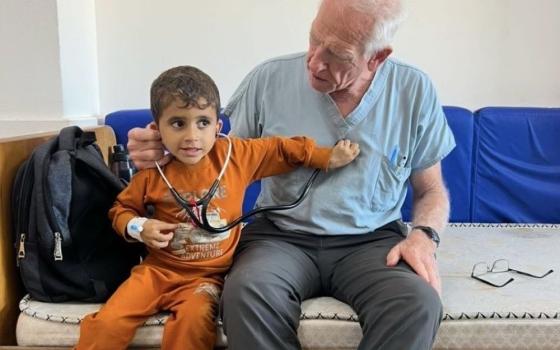Holy Week: Accompanying El Salvador
Holy Week began for Jesus with an anointing. At the house of Lazarus, Martha and Mary in Bethany, a suburb of Jerusalem, the disciples threw a banquet to honor Jesus’ triumphal entry into the holy city at Passover time. Mary broke open a precious vial of aromatic oil and poured it over the feet of Jesus, wiping them with her hair. Her extravagant display of love turned his triumph toward the cross, and her insight that his beloved body must be prepared not for the throne but for the tomb infuriated the other disciples.
 It was a waste of money and an affront to their hopes that after three hardscrabble years of climbing up and down the dusty roads of Palestine they were almost at the top, Jesus and them, a messianic tour on the verge of success.
It was a waste of money and an affront to their hopes that after three hardscrabble years of climbing up and down the dusty roads of Palestine they were almost at the top, Jesus and them, a messianic tour on the verge of success.
By Tuesday, Mary’s spoiler would add to a shift in mood to talk of betrayal. A somber Jesus, still reeking of perfume, looked them all in the eye and said, “One of you is about to betray me.” Taking a morsel of bread and dipping it into the common dish, he handed it to Judas. Perhaps he loved Jesus even more than Mary of Bethany, and it was out of jealous rage and disappointment that he tried to redirect Jesus toward power instead of some futile, wasteful self-sacrifice.
Our delegation began the week with an orientation session in which we were asked, “Why did you come to El Salvador?” A lively contingent of students from a Seattle high school, church groups from San Francisco and Kansas City, individuals on personal pilgrimage, SHARE staffers and one embedded journalist, we were all still trying to get our bearings. A common theme emerged from our reflections: We came because we were invited. Our paths had converged here, and only some mysterious grace could fully explain why we, strangers, were about to cross a threshold together that we knew could alter the trajectories of our separate lives toward a different future, with unforeseen consequences. Anointed with sunscreen, smelling like coconuts and feelng the first hint of sweat even early in the day, we were already becoming a community of friends, entering the holy city of San Salvador to commemorate the death of a good man.
Thirty years earlier, to the day, Monseñor Romero, fragrant with the love his people lavished on him with outstretched hands at every opportunity as he moved among them, was in his final days. Betrayal was in the air, death threats mounting by the hour. He had already endured a martyrdom of calumny and vilification in the daily newspapers owned by San Salvador’s powerful elite. His deepest anguish came from a relentless distortion of his words and motives by some of his fellow bishops, aligned with the wealthy and secretly channeling their criticisms through the papal nuncio to the highest levels in the Vatican. They blamed Romero for the violence being unleashed on protestors in the cities and peasants in the countryside by the security forces and shadowy death squads sponsored by rich landowners. If only he had left well enough alone, stayed out of politics, there would be peace, law and order.
The violence was brutal and rapidly escalating in a spiral of murder and revenge, hostage-taking and torture by both sides. Romero was asked by a visiting journalist what his job was and he said, “I pick up bodies.” In the absence of official policing and judicial processing, the archdiocesan legal aid office recorded every murder, disappearance and testimony of torture and, in his weekly homilies at the Cathedral, Romero read the lists of names and described the crimes, demanding that the government do its sworn duty to investigate and prosecute each atrocity.
In a candlelight procession from the landmark statue of the country’s patron, El Salvador del Mundo, Savior of the World, to the downtown Cathedral for an open air Mass, our delegation surrendered itself into the flow of thousands of Salvadoreans and international visitors who had come to mark the Romero commemoration. Even young President Funes, the first progressive to hold the office in 20 years, joined the procession, though surrounded by a phalanx of nervous body guards, to demonstrate his commitment to “walk with the people” as Romero had. After a brief and fast-moving push through the delighted crowds, Funes and his wife disappeared into a waiting security cortege of black Suburbans with flashing lights followed by a pickup truck carrying soldiers wearing bullet-proof vests and wielding automatic weapons.
San Salvador is the murder capitol of all of Latin America, surpassed in daily body counts only by the recent surge of killings in drug-ravaged Juarez, Mexico. Mostly gang-on-gang executions, the violence has at times exceeded levels during the civil war. The gangs, homegrown and enhanced by deported criminals from the large Salvadoran immigrant communities in major U.S. cities, have replaced the war’s death squads as contract killers with a veritable army of tattooed and pierced youth, a lost generation dumped onto the streets by a failed system for higher education for the country’s growing population, now half under the age of 30, and a jobless and faltering economy that offers little hope even for university graduates. Proficient in signature-style murders that include decapitation and dismemberment, the gangs permeate San Salvador and the rural areas, using their own roadblocks to extort travelers and their own tax collection by demanding protection money from businesses. In a country where archbishops can be killed with impunity, even a sitting president has to watch his back.
The city center where the large Cathedral and the huge, ornate National Palace frame a spacious open plaza, food vendors and hawkers of every imaginable commodity, from toilet paper and small plastic bags of sliced papaya to ballpoint pens and pirated DVDs, make up a teeming warren of metal-roof stalls along the narrow streets to form a popular marketplace the equal of anything Dickens might have conjured up based on 19th century London, thick with desperate poor people working the crowds for pennies. It is the antithesis of American mall culture, more vibrant and spontaneous than any plan for gentrification could possibly capture or contain. Women breast-feeding babies sit before wheelbarrows overflowing the cola nuts or small braziers cooking strips of meat and corn tortillas. Repeated attempts to license vendors or clear the city of homeless people and street beggars have failed to reclaim the central city from a culture rooted in poverty and distrust of official intentions. Along with its share of natural predators, the dense and intricate cobble of people found here day and night are the same people Romero saw as his church, the people of God, worth laying down his life to defend and nurture.
This same poverty and untapped human potential is mirrored in El Salvador/s outlying cities and towns. The next day our long, white bus, piloted by Santos, both driver and protector, and loaded with large blue plastic containers of potable water, hauled our group with gear-shifting, horn-blaring proficiency through the seeming chaos of city traffic to the crowded highway system and delivered us three hours later in the city of Cabañas. The northern tier of Departments (like our States) in El Salvador, are home to a battle between community activists and large multi-national developers focused on mineral extraction, hydro-electric power plants and tourism now being touted along the projected leg of the Pan American Highway that will connect Winnipeg to Buenos Aires as key to recent trade agreements NAFTA and CAFTA that promise to increase commerce between North and South America. Pacific Rim, a Vancouver-based mining company, has long had its sights on gold and silver deposits in the rich volcanic soil of Central America.
After securing exploration permits, the company’s plans were halted by environmental impact studies that warned that mineral extraction using cyanide flushing techniques would endanger vital water resources for the entire country. President Funes, the Catholic bishops of El Salvador, and a well organized activist movement oppose mining operations, but the incentives are huge and the precedent critical for all large-scale projects by other multinationals eager to invest in Latin America. The promise of another El Dorado has divided communities desperate for jobs and development at any cost, and three activists, including a young pregnant mother, have been murdered in recent months in the controversy.
After Cabañas, our group stopped to walk through the small town of San Ysidro, greeting people along the cobblestone and dirt streets. The director of the community center there is the most recent victim of the mining crisis, kidnapped, murdered, his body thrown down a well. We interviewed the center’s staff and, later, SHARE executive director Jose Artiga said how important it was that we had walked through the town. “The killers were watching us,” he said, “and knowing that we are aware and will respond if anything bad happens to these activists may deter further killings.” This is the essence of the accompaniment SHARE is promoting.
Romero’s decision to accompany the poor, to give voice to the victims of violence and to demand justice and due process in the development of social structures for the common good was a threshold he chose to cross when he became archbishop of San Salvador. Three years later, that decision cost him his life.
Our presence in El Salvador represented a seemingly insignificant first step for us to cross the same threshold. Where it takes us is a matter of grace and many future decisions, but we can say it started here. We have been anointed.
[Pat Marrin is editor of Celebration, NCR’s worship resource. He was in El Salvador covering the events surrounding the 30th anniversary of the assassination of Archbishop Oscar Romero, which was March 24.]
March 29: Holy Week 2010: Accompanying El Salvador, an introduction
March 30: Anointing
March 31: Darkness will have its hour
April 1, Holy Thursday: Fools rush in
April 2, Good Friday: Know when to fold 'em
April 3, Easter Vigil: Know when to hold 'em
See also
|



